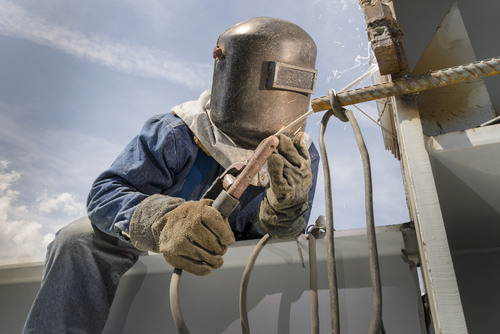Whether you’re a large, heavy equipment manufacturer with a stable of experienced welders or a small job shop where welding equipment is used infrequently, odds are you use the same type of equipment: a metal inert gas (MIG) welder.

This kind of welder is by far the most common and most versatile welder, adaptable not only to many different user skill levels but also to many different materials and applications. However, it is important to be aware of MIG welding hazards so that you can protect your workers.
MIG Welding Hazards
A MIG welder is a type of shielded metal arc welder that uses high-voltage electricity to melt and form a metal wire that’s fed through the welding torch and applied to the point of the weld. When cool, the metal forms a bond between the two welded objects.
To protect the weld from oxidation, an inert shielding gas is typically fed through the torch that protects the welding zone. In another variation, the shielding gas is generated by a coating on the wire itself (flux-cored wiring), but the arc and the gas shield are characteristic of all MIG welding.
As you might expect, the combination of an electrical arc, hot metal, and gases poses a range of hazards to welders and other workers in the area, including:
Fire hazards. Welding is just one variety of “hot work,” or work involving active use of an ignition source. If you have an ignition source and breathable air—two legs of the “fire triangle”—you must take care not to have the third leg (flammable and combustible materials) present.
Respiratory hazards. Welding comes with multiple respiratory hazards. The metal being welded, the filler material being used, and any substances on the surface of the object being welded (such as paint) can be vaporized, creating toxic smoke and fumes. The inert gas used to shield the arc can accumulate in the work area, displacing oxygen. The process can also generate carbon monoxide gas at potentially toxic levels.
Eye and skin burns. The bright, hot arc that melts the metal wire is dangerous to look at directly, capable of causing burns to the cornea (the outer membrane of the eye). This hazard affects welders and anyone in the area who can see the weld zone.
The ultraviolet light generated by the arc can cause sunburn. Drops of melted metal splashed and sprayed from the weld zone can burn exposed skin, and the workpiece itself will be hot to the touch for some time after the weld is completed.
Ergonomic hazards. Welders often position their torch and workpiece with their helmets raised and then jerk their heads to snap the helmet closed as they light the torch.
Repeated frequently over a long period of time, this motion can lead to repetitive motion injuries in welders.
In addition, workpieces that are not optimally positioned or job tasks that require welders to contort their bodies can contribute to ergonomic injuries.

Your article has outlined very clearly the dangers of Mig welding. You also gave the solution. Thank you for a great article.!
Great info, I’ll be sharing this link with the guys are the shop, most of them are totally unaware of the various welding hazards. Hopefully they’ll finally learn why I’m so adamant about welding safety procedures!
Just looking at someone who welds with all the flying sparks around the person makes you think that it is one of the risky job out there in the field. This is why it is very important to wear a proper working gear that could protect you from any harm that may occur when working.
Your article is just like juice for welding job related persons. Its a great and fruitful article for them. You can also add “electric short circuit hazard” in your awesome article. Thanks.
This article should serve as a warning message to weekend warriors who take on welding jobs without realsing the dangers associated with it.